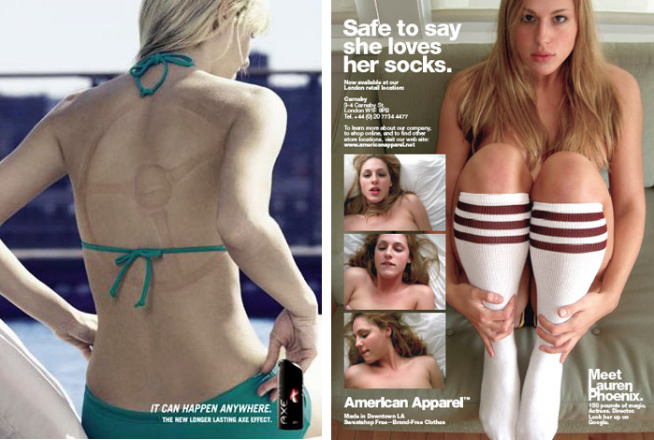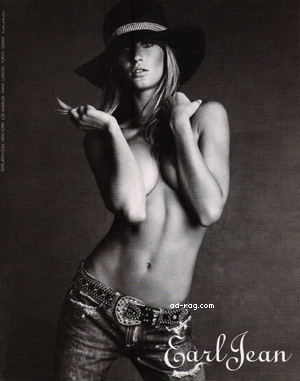
If you judged our society based on the ads alone, one would wonder if we cared about anything but sex. True it is a part of our animal instinct, but at the same time, is it possible might not relate every item that we purchase to some way bringing us closer to the carnal act? From clothing to scent to items as boring as writing impliments, it seems gratuitous sexual images or innuendos find their way into ads.
Of course this is nothing new, but Tess Alps ponders today upon "Sex sells - when it's allowed to, that is".
So sex certainly sells media products, and it can work for others, where permitted. Advertising, quite rightly, is not allowed the same latitude as editorial, because it arrives unsolicited and unannounced. However, advertising needs to keep up with shifts in consumer attitudes, or it risks looking quaint and irrelevant. However, as soon as there is a suggestion of women enjoying any sort of sexual pleasure, some outdoor contractors will refuse the ad. One Harvey Nichols execution, featuring underwear-clad women riding joyously on giant lipsticks, was turned down because "objections were raised to the phallic imagery". Well, at least they got it.
As this is written from the UK, Alps also notes that the ASA "does not permit gratuitous sexual imagery". Which is not a bad policy. Besides the fact that gratuitous is less shocking these days. It might ruffle the feathers of certain audiences but for the most part, the ads aren't targeting those groups and probably don't really care too much about how they feel. Especially when it comes to going after younger consumers- if their parents are offended by it, then it will probably (although not always) be considered "cool" by the kids. If the parents like it, it can be an automatic turn off for those kids who are in a phase of rejecting what their parents and elders find fitting. Beyond all that, gratuitous sexual images are just that -gratuitous. If they aren't helping the brand or communicate the message in the advert, then there really is no point in using it. What does beer have to do with half-naked women? Nothing. What do jeans have to do with half-dressed women? Nothing.

What about pens? Nope. A woman's film festival? Close, but no way. But they create chatter. Recently it seems like fewer ads are using sex for the sake of using sex, although there are still plenty of brainless concepts out there that rely on the use of naked bodies or innuendo to move product. And with that we've also seen some more equal gender use of sex to sell as well, with brands like Mike's Hard Lime. Advertising blogs, like Adfreak, have picked up this pointless use of sexual imagery like this story about Birkenstock and Tony Little , yet the image is of Little with women from Hooters (yes he did appear in a Hooters spot, but when the main story is about Birkenstock, why is there a need to show women from Hooters?) Or this post about McDonalds and Heidi Klum, rather than opting for a McDonald's logo or picture of the Big Mac as they do with many other of their posts, they picked a picture of Heidi in a bikini. Are they following on the heels of other blogs which use sexy babe images to get people to their sites? Possibly. For a site like Adfreak, it's a fuzzy line - as their blog is a part of Adweek- and therefore an extension of a brand that many ad folk see as one of the ultimate in advertising journalism. Plus, they have more to offer like inside knowledge, close contact with all sorts of adpeople (in the US), lots of funny scoops and NYC-centric ad-gossip about who's where and with what major brands and the sort, instead relying on cheap girlie images that mimic sites probably visited more by horny teenage boys and men in their mid-life crisis. So what does it mean when they start throwing in unnecessary sexual images? It's bad enough that as an industry we use these pointless images to communicate when it isn't necessary, but for our industry news publications to do so, it is pushing the limits even further. I'm far from a prude, but overusing this kind of imagery is old and tired. And it seems that when a creative team can't come up with a good concept, these hacks rely on using sexy images and innuendo to try to "make" an idea. In August of last year, we were told that sex no longer sells after a study "discovered" sexually explicit images in advertising doesn't brand anything, and bores the young creative consumer. Not that it stopped Calvin Klein from continuing to try.

So from that perspective, taking that route has become less effective. There is always the hope that this tactic will get someone upset and then get the media talking about it, in the tradition of FCUK. But many are tired of hearing about FCUK and this method only works for so long before even the most prudish of people realize that it's nothing more than a stunt for free PR. So my point of this rant is this: If what you're selling has nothing to do with sex, stick to a concept that works for the brand, rather than just trying to put some sexy image in where it doesn't belong. And even if the brand easily can be paired with sexy images or some kind of innuendo, remember that if all your competitors are doing it as well, you're not going to stand out from the rest of them if you follow the same tactics.
- reply
Permalink- reply
Permalink